October 2, 2016
Martha O'Kennon
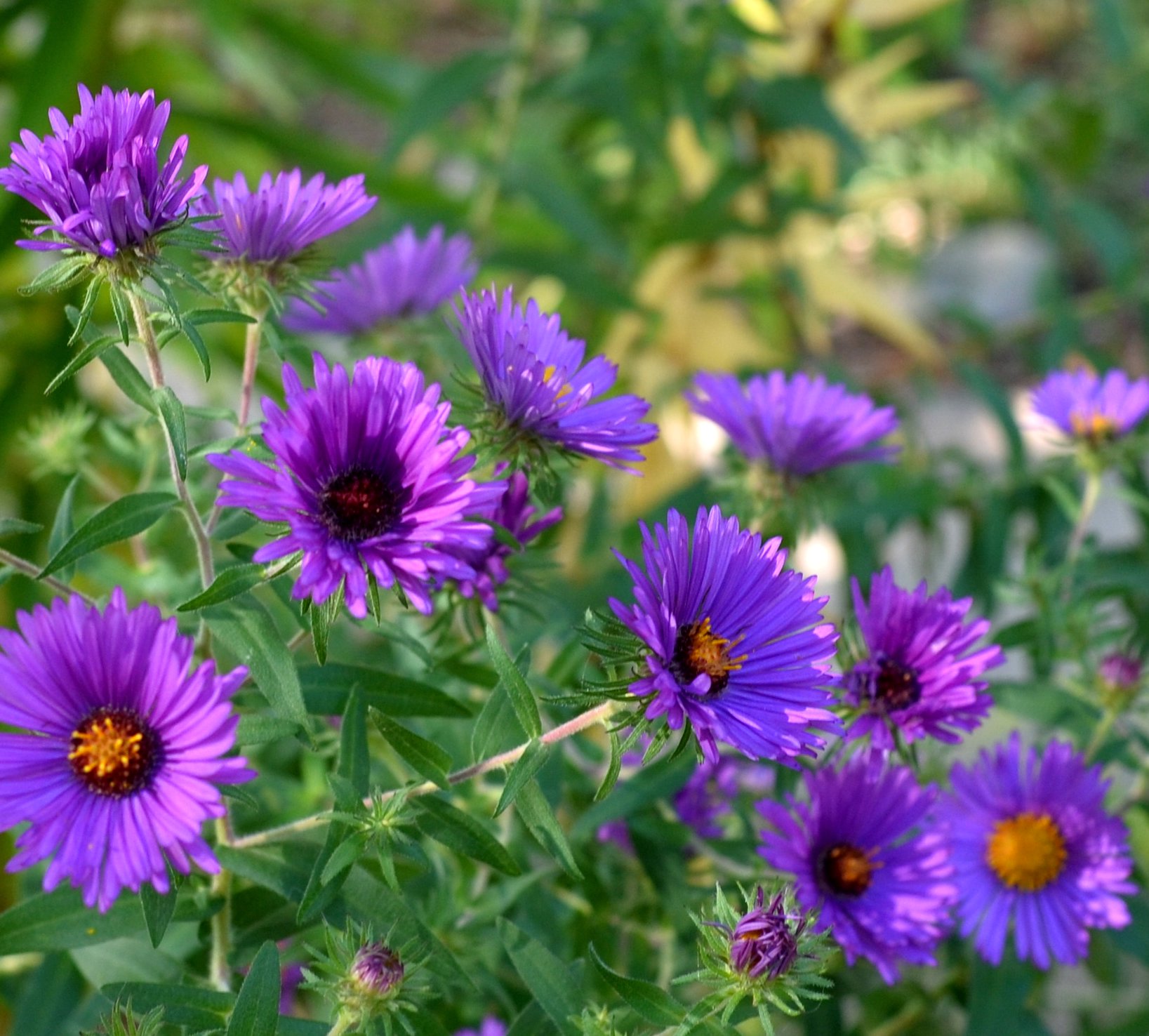
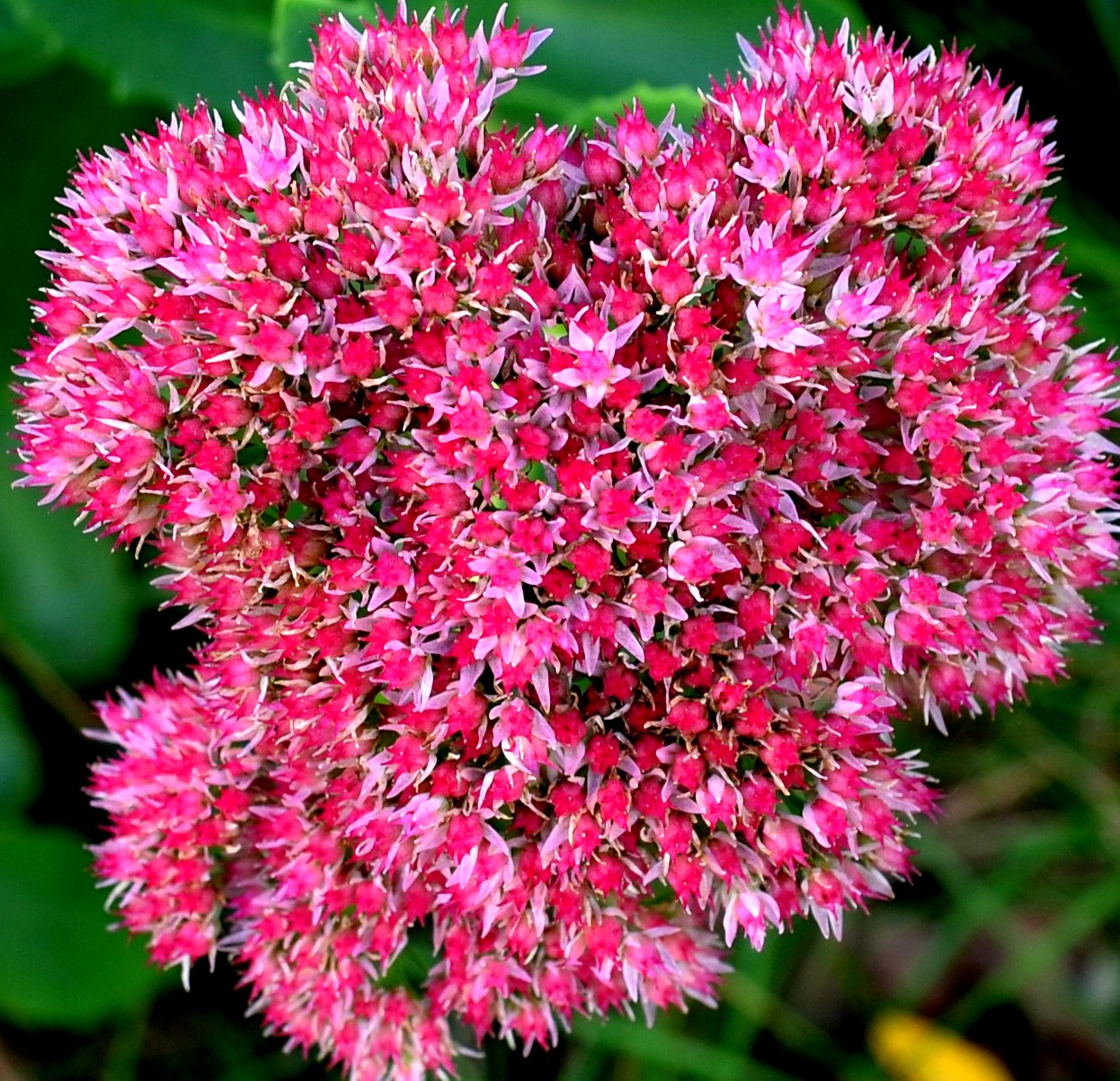
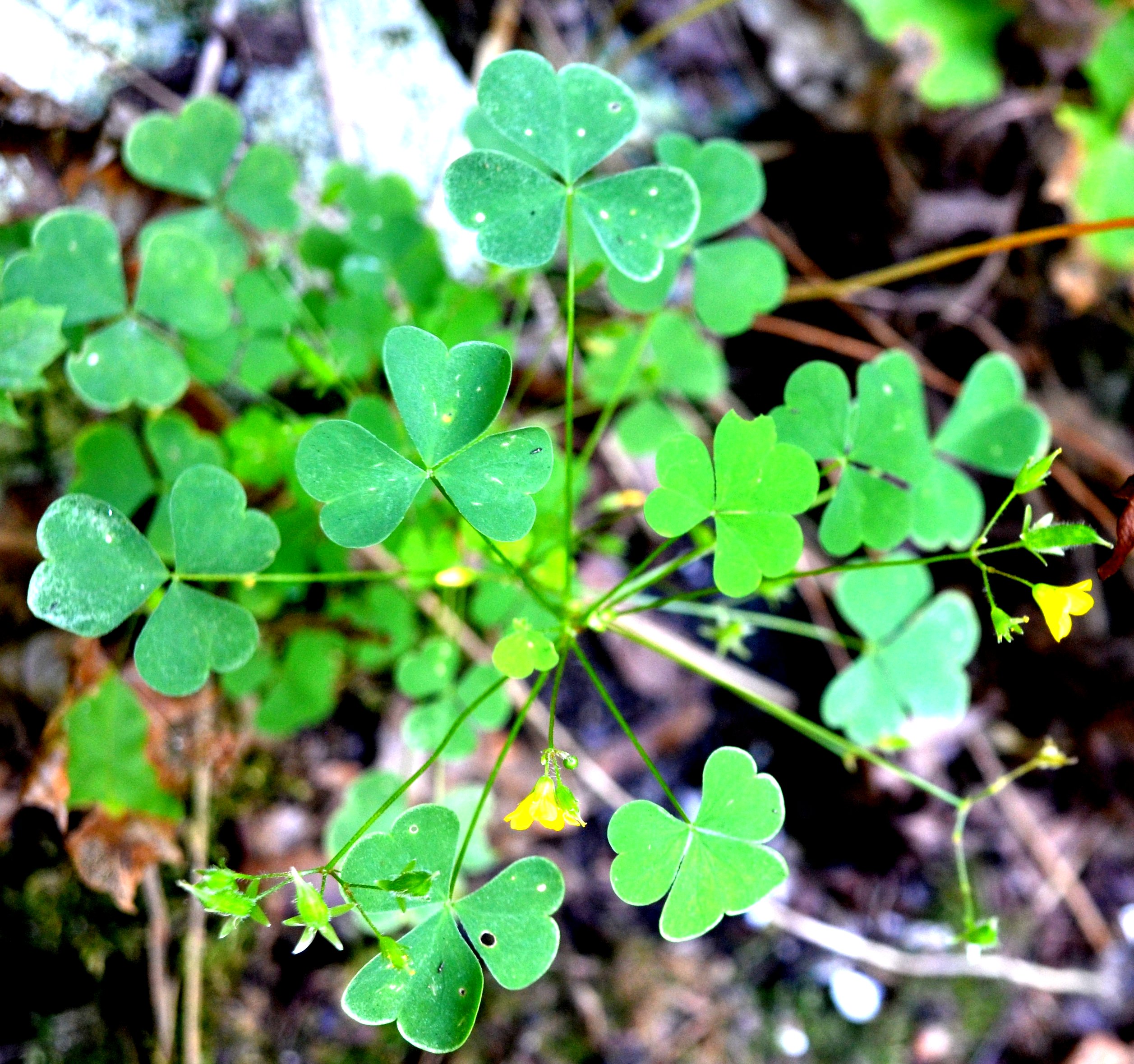
Fall continues as Fall always seems to continue. A couple of days of rain and a week of fairly cold temperature kept the bees and hoverflies largely at bay. The magnificent asters you see in these pictures are headfirst bowed into the ground. But who knows what it will be like next year? The next two pictures are of the Autumn Joy at the height of its beauty, and a handful of Wood sorrel or Lemongrass. In this blog, we'll be taking a couple of trips down Memory Lane to remember how things were last year at this time.
Remember that there is information in the name of the file for each image. You can see it by mousing over the image - look at the lower left of the screen.
I would try clicking on the image. If the little "+" sign appears, it means you can enlarge again. While it is in "+" mode, click on something you want to see more clearly and it will zoom to that section. Then the info is displayed in the address line above. If the image has been cropped
so that clicking on it doesn't result in a larger picture, you can always hit control-plus to increase the size of the image.
No ants? No, it's just that I didn't take any ant pix this week. But bees? Yes. There is a little one with a black abdomen, a honeybee, and (maybe) one of the larger of the Halictus bees. I am so confused with bees these days. I keep going round and round and round.
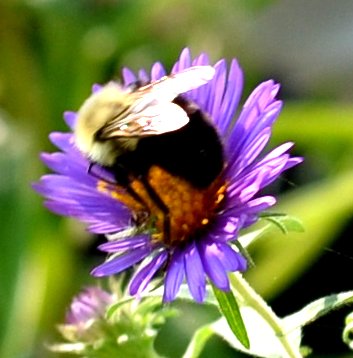 <
<
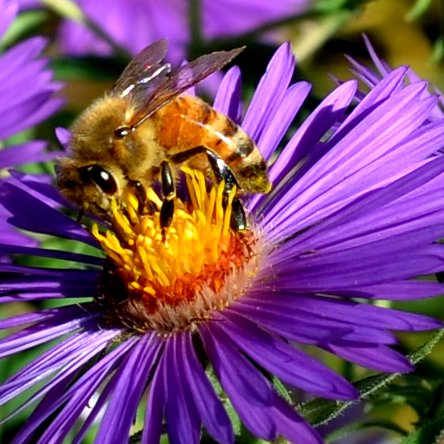

Here's that Halictus or another but this time covered in pollen, a mason bee just coming in for a landing, and a darker honeybee. I am particularly fond of this bee with all three legs (on this side at least) covered in bright yellow pollen. I submitted it this afternoon to Bugguide and it seems to be a Miner Bee, probably Andrena aliciae.
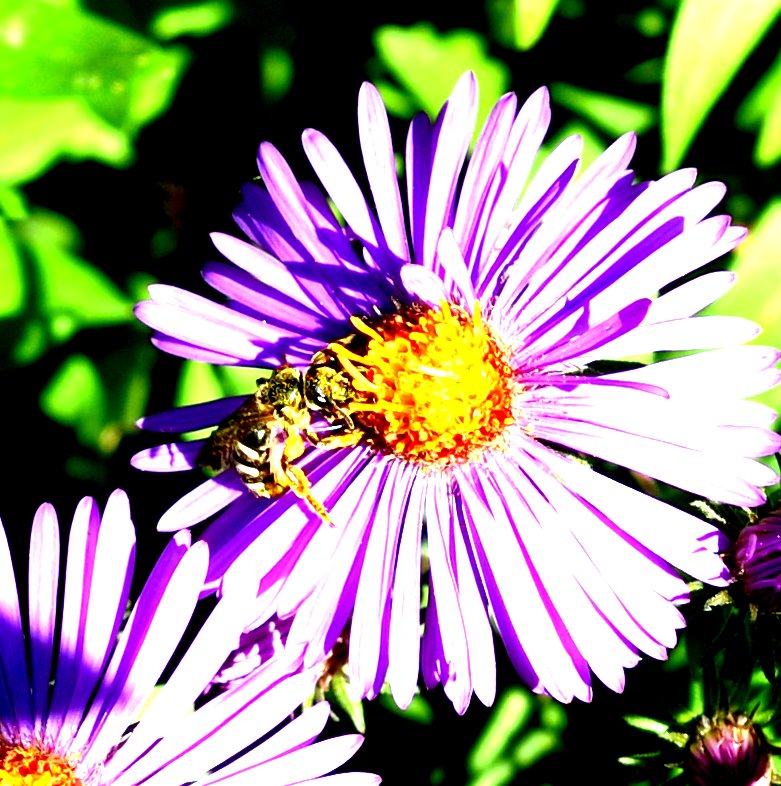
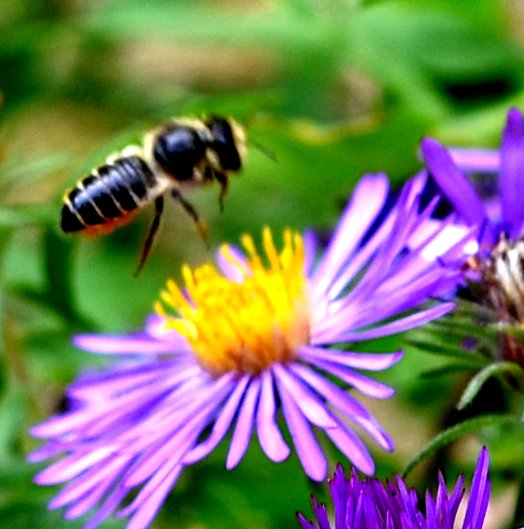
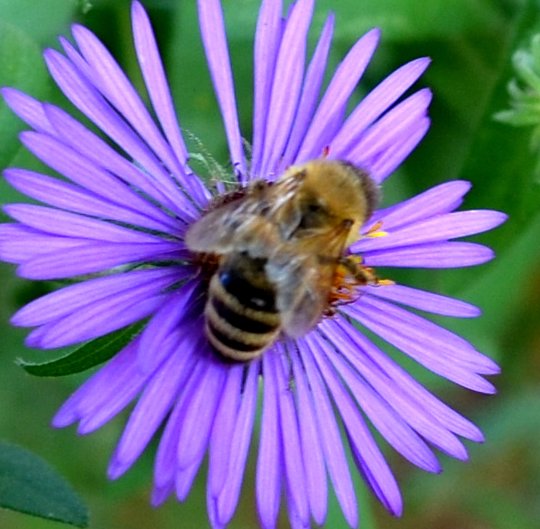

An old friend, a Lightning Bug (beetle); a tortoise beetle which looks like a tiny tiny vinyl disc covered with that light golden covering; and one of my favorite beetles, the Rhubarb weevil. From what I've been reading, it doesn't like Rhubarb anywhere near so much as Prairie Dock (right, botanists?), whose leaves loosely resemble rhubarb's. It's my favorite because earlier in the season, it is yellow with a big black nose (the thing that shows this beetle is a weevil.) and so really resembles a banana peel. I always call it the Banana Weevil, must make a note to stop doing that.
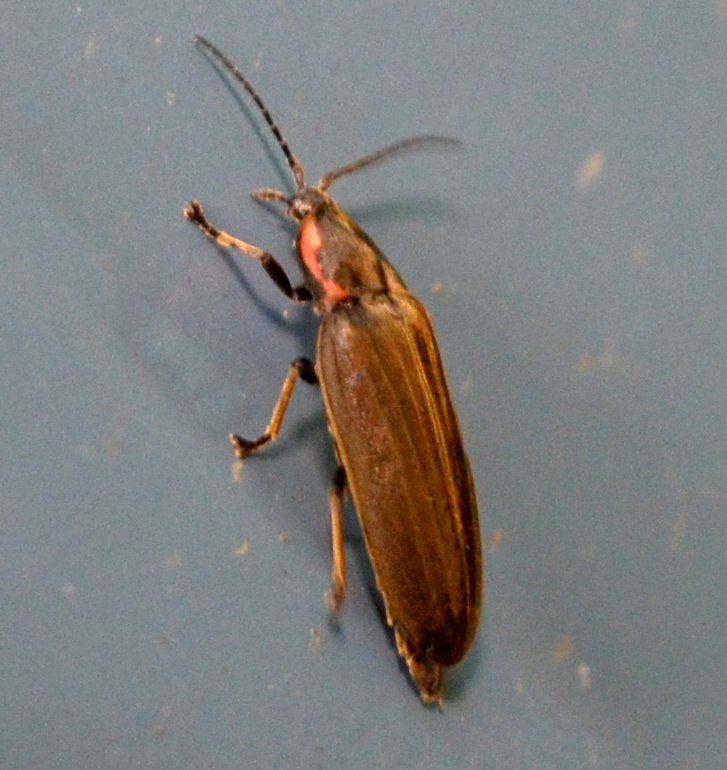

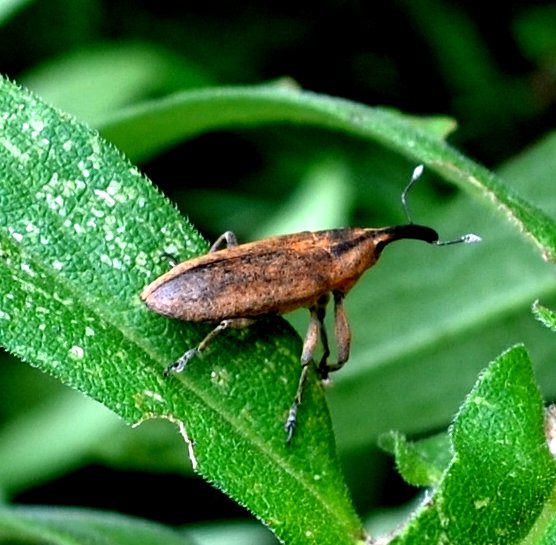
On to bugs. Another ambush bug appeared in the goldenrod this week. It looks a bit different from the ones I had been seeing.
The claws of the other males were orangeish and their backs were darker and in a larger area. The old females had less dark brown and pale green claws and legs. This one seems dark and with greener claws. There is supposed to be some difference in the length of the "apical antenna segment": the P. americana longer than in P.pennsylvanica. I just don't know. I couldn't see the antennae in most of my pictures. I'll stay on it though. The next image shows a nearly ripened trumpetvine pod with a little Zelus assassin bug nymph.
Third was a mysterious find. I don't know if you remember the Phantom Crane Fly that I wasn't able to photograph last year. It had a black body with white at the joints so that it resembled a big snowflake floatng in the air. Anyway, I submitted my picture of the new "thing" to Bugguide. The first person to take a crack at it called it a "stick bug". So I dutifully looked up the walking sticks and none looked just right. The next person identified it as a "thread-legged bug" of the Subfamily Emesinae. Isn't it incredibe? It looks like a dried-up plant part to me. But the Bugguide person said to look at the front legs, which are thicker than the other really threadlike legs, and could be useful for grabbing. He also said to look at the rostrum (the mouthpart that I always call the slurpy-maker) and sure enough there it was! Note: Assassin bugs and Ambush bugs and Thread-legged bugs are all assassin bugs.
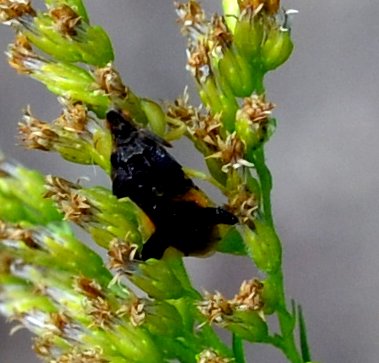
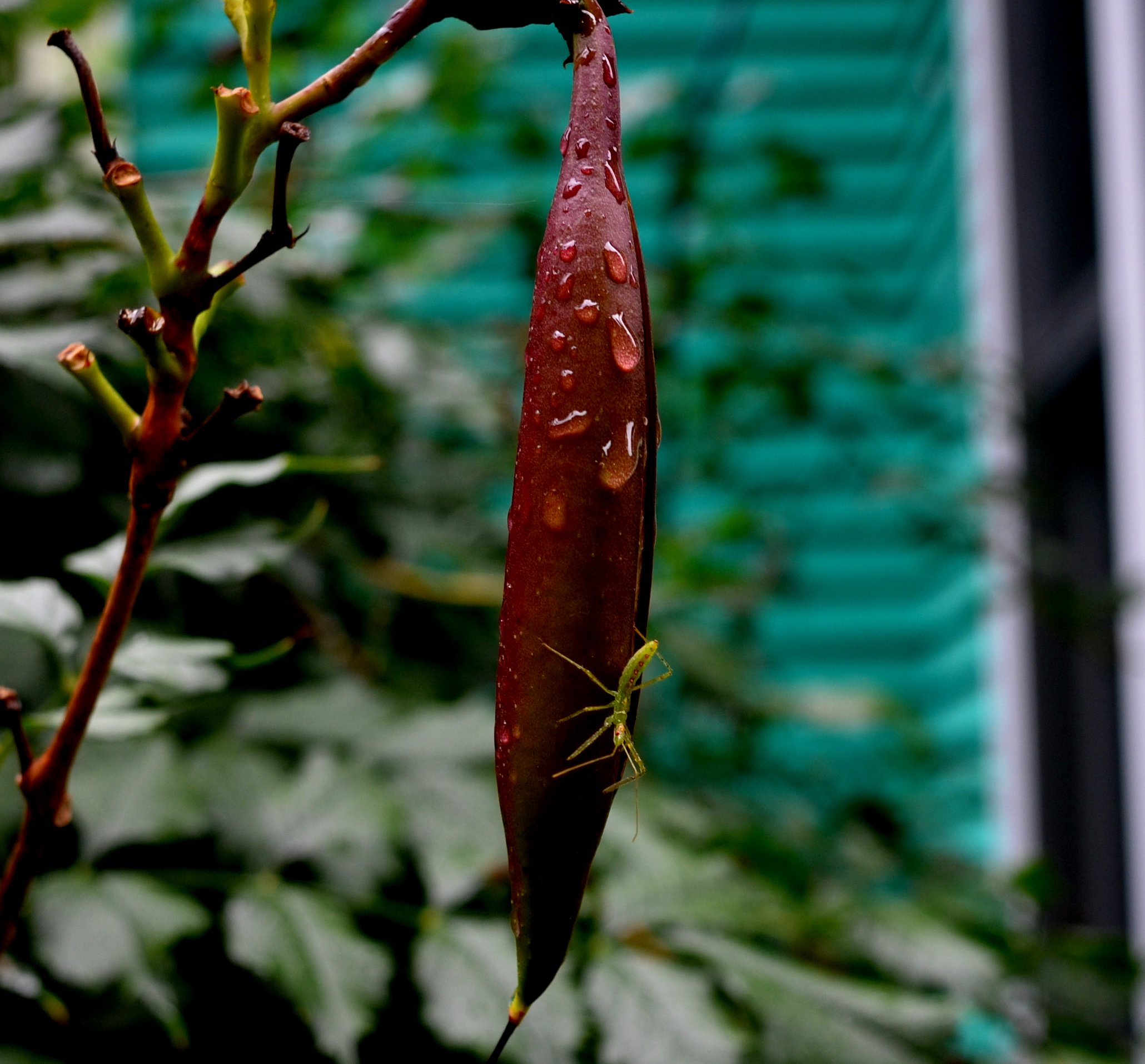
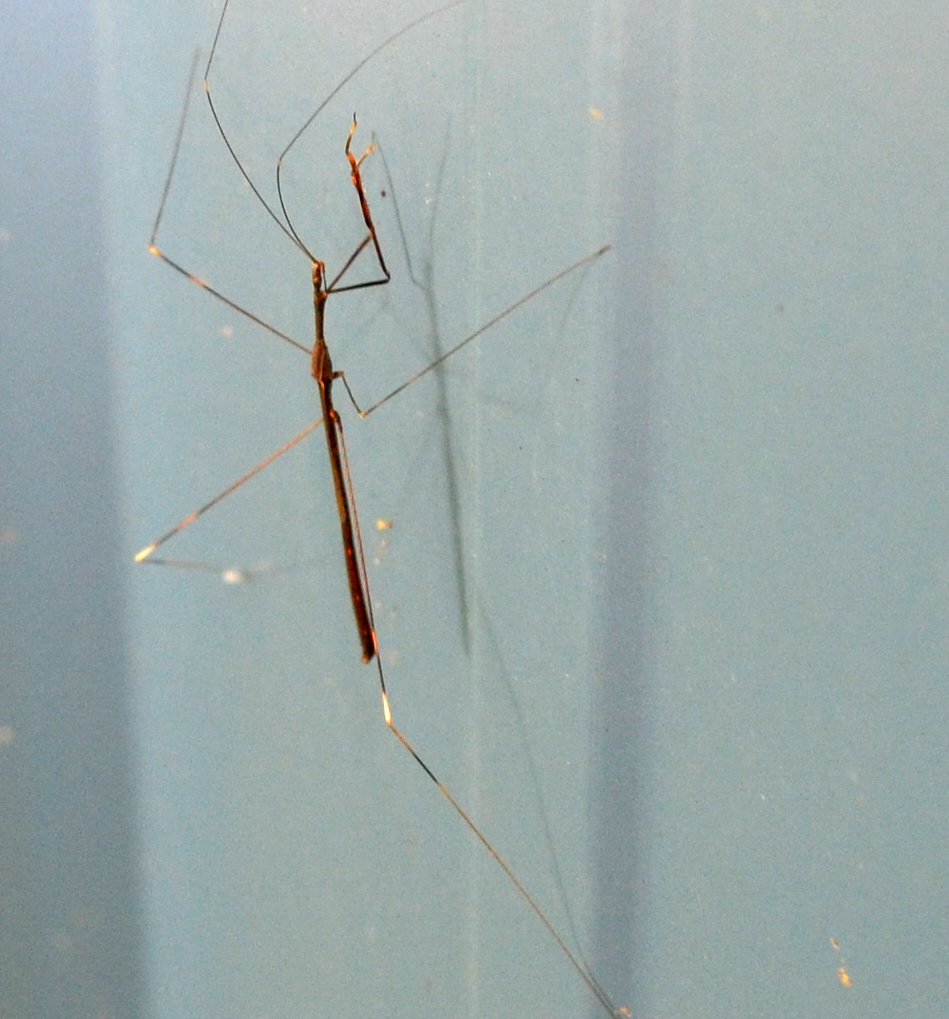
Leafhoppers still show up once in a while. Here's our old bestie the candy-striper; our next to best the Coelidia olitoria (the one with the really cute nymphs); and one that I've no idea of what it is. It is either a leafhopper or a bark louse, which is neither bark nor louse. December 18, 2020: It is a Barklouse, Trichadenotecnum alexanderae. Almost too hard to see even with trifocals. Sorry to make excuses based on age! Hey, wait. I got my first Trifocals when I was thirty!
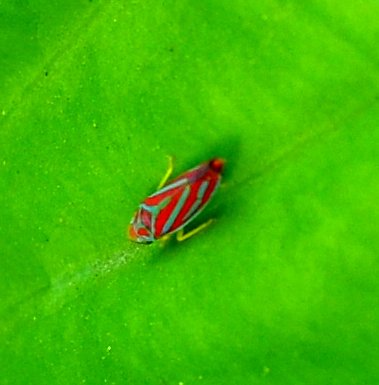
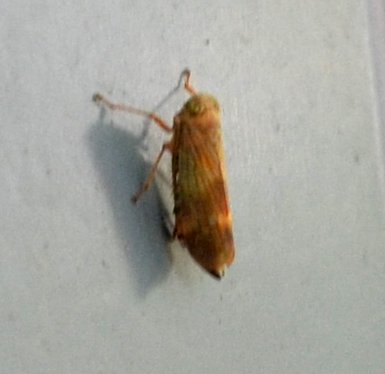
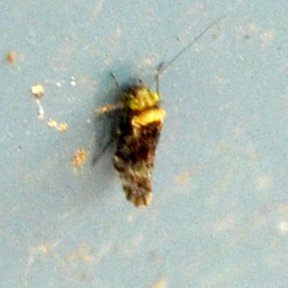
Here is a Lygus plant bug, which seems to start showing up about now - at least we start to be able to spot them on goldenrod especially. (Just as the goldenrod starts to fade of course.) This baby was discovered by a spider and seems to have lost its head in the process. One more mystery bug (or maybe beetle - the back is sort of hard to make out.) Doesn't it look like a small mammal that your baby would love to play with? It is a Barklouse, Polypsocus corruptus!
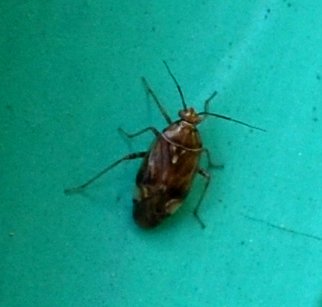
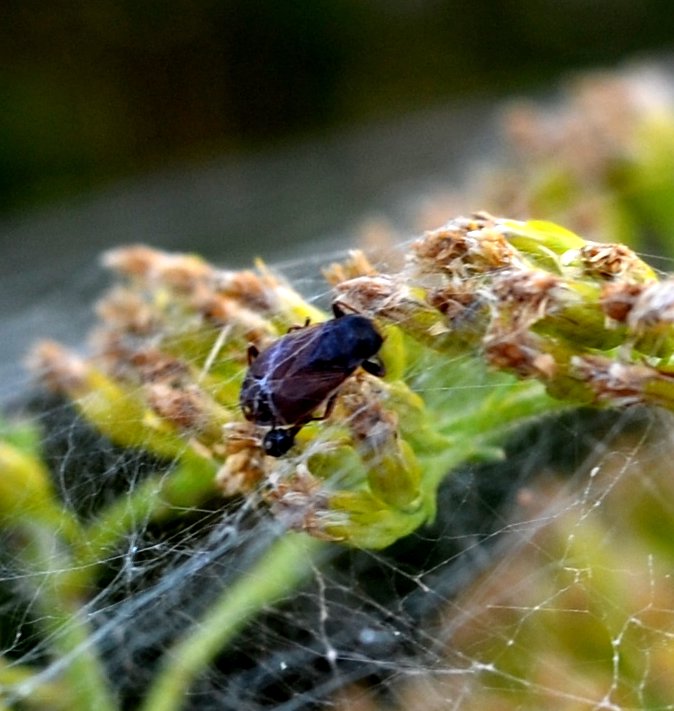
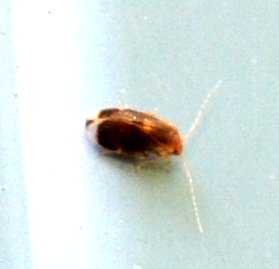
Remember how we keep seeing the brown and the black spittlebugs mating in public? Well, this week again I just snapped at something I oouldn't really see well and again it turned out to be two of those spittlebugs making a commitment to each other.
One caterpillar. The geometrid moths are named so because their larvae seem to be measuring the earth beneath their six real feet and a few more fake feet. Speaking of larvae, I haven't seen the big hornworms Kathleen gave me for a couple or three weeks. And the nightshade, which I finally did an ID on, is NOT the deadly or the purple nightshade. Still, even if the berries look delectable, they are probably poisonous in the Woody Nightshade.
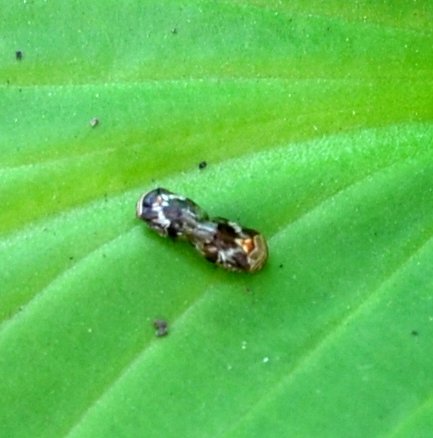

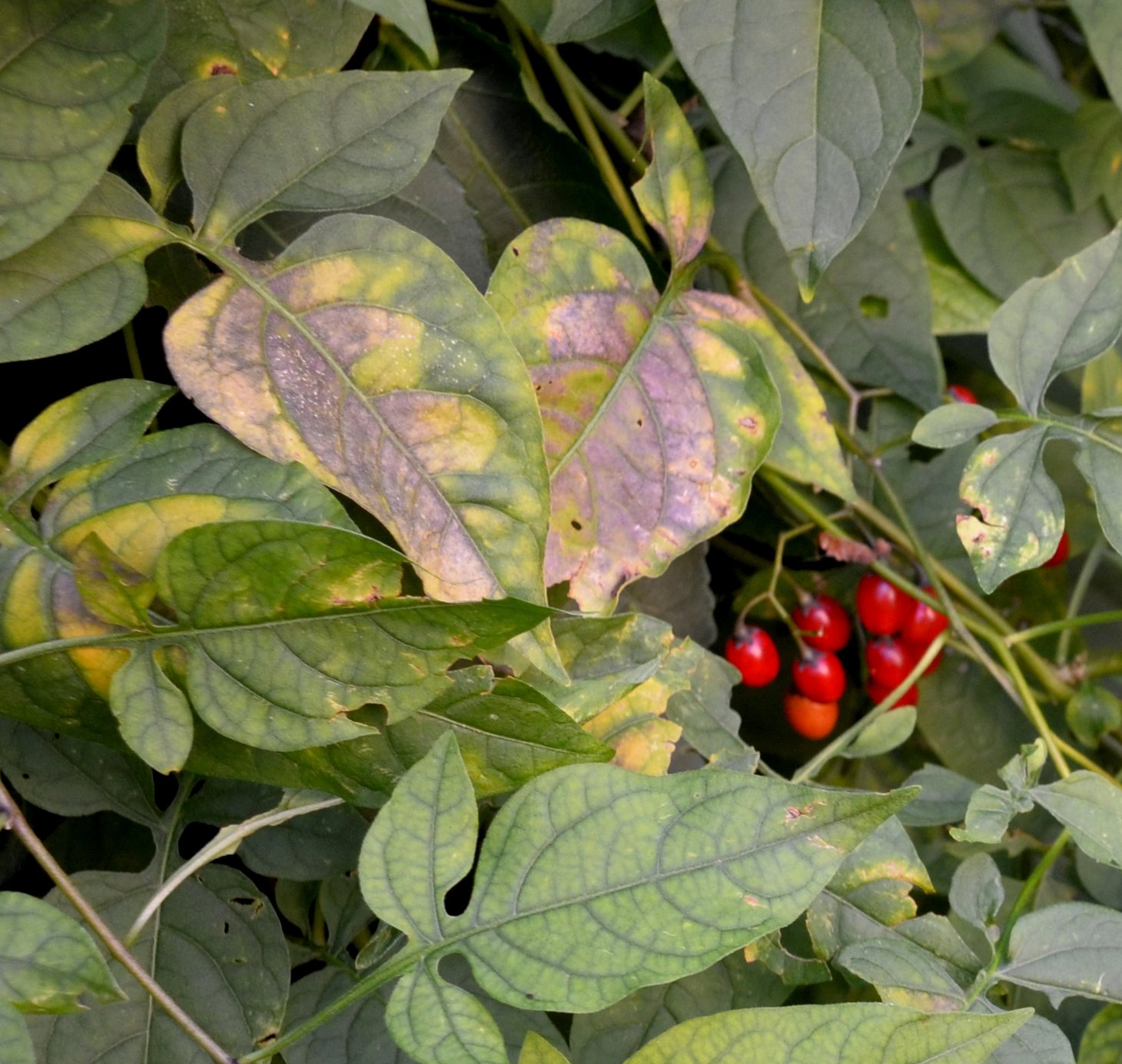
We made it to the flies. Sphaerophoria is probably the most common hoverfly around here at this time of year. This black-thoraxed one is Rhyngia nasica. It has the distinction of having a big "nose", a snout that sticks out farther from the face than most hoverflies. But these next two are ones that we saw last year at this time but not this year. This larger fly is the Helophilus fasciatus, which did appear here in the spring. It's the one who lays her eggs on the surface of the pond, and they live on dead plant matter. And the last one appeared last year in the third week of September, but so far not this year.
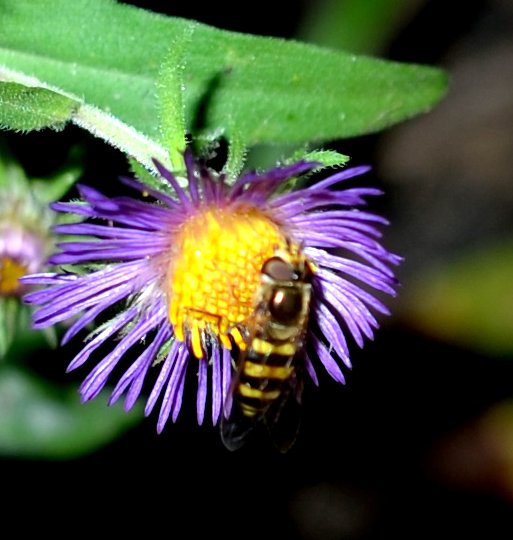
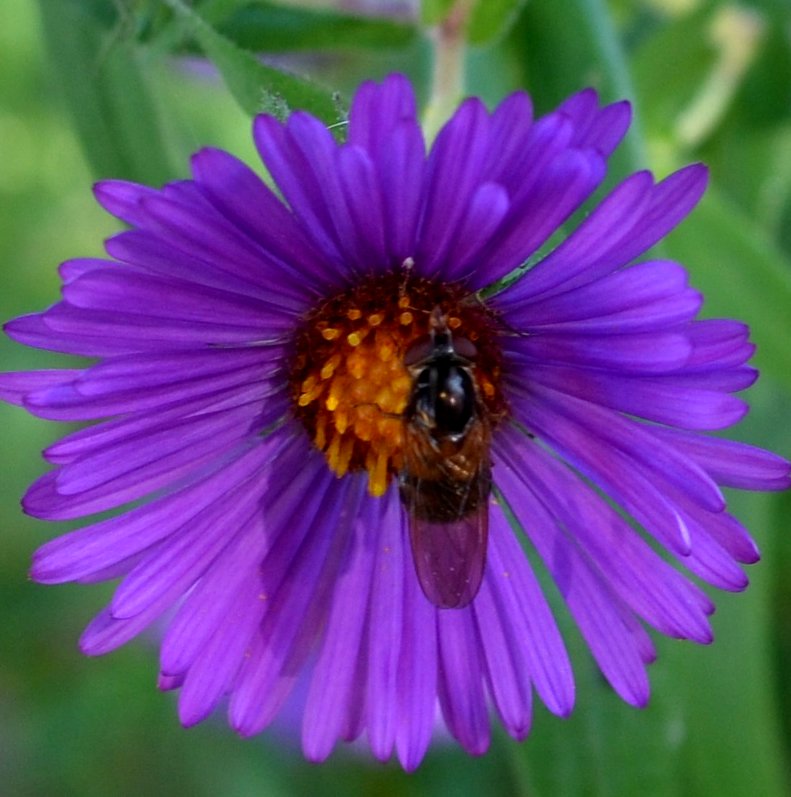
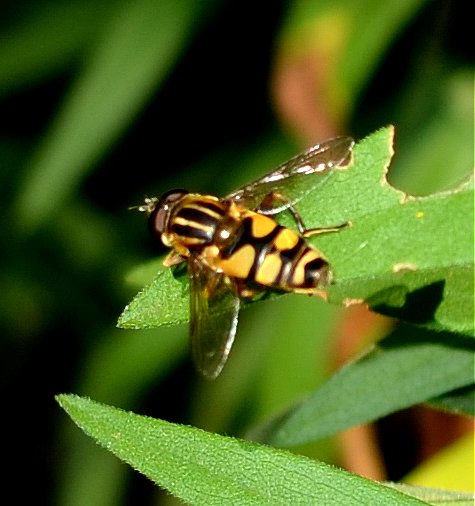
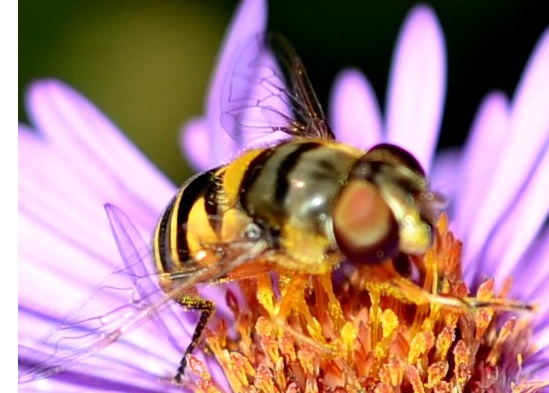
It is hard to tell the difference between a small crane fly and a large mosquito. This first one looked like a large mosquito but I'm almost sure it is a crane fly. The next one looks to me like a gnat. And the last is an Aedes mosquito, a female as you can see from her long piercing appliance on the front of her face. Remember most if not all the Aedes have black and white banded legs. By the way, the mosquito attack seems to be waning. Even though the dive-bombers were annoying, the bites didn't seem to be so bad as last year's. Happy thought: Mosquitoes, like wasps, are Amazons - only the females bite or sting. So only sidle up to the males.
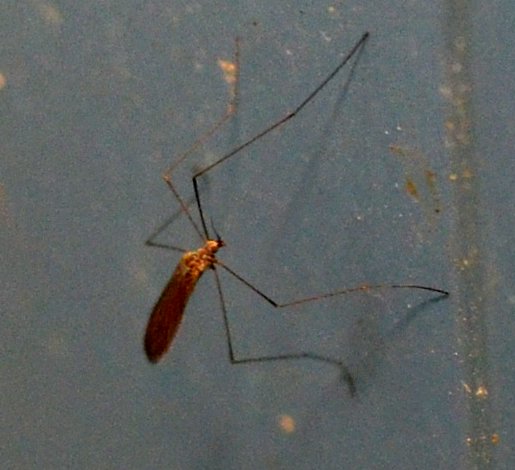
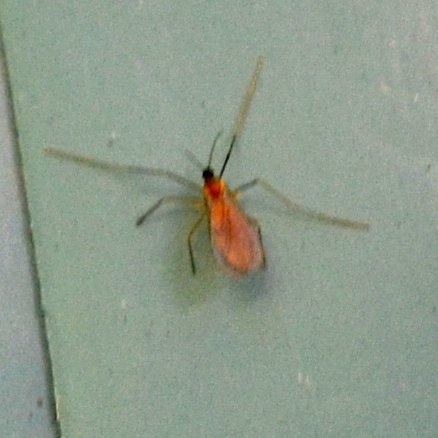
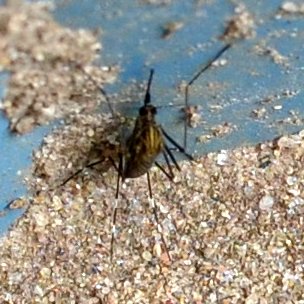
This fly with the yellow wings seems exotic until you remember how many they are. Still... And once more for the tiny(1mm) fly who took on a blue tint after being run through the cleaner-upper (light and contrast modulator). And the red-headed fly we've seen so many relatives of. And the green blow fly - looks even lovelier against the purple of the aster.

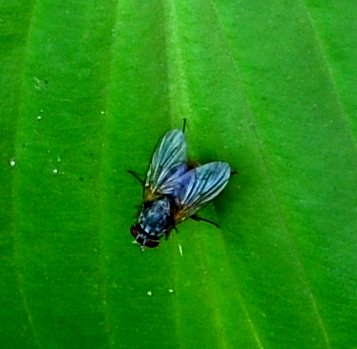
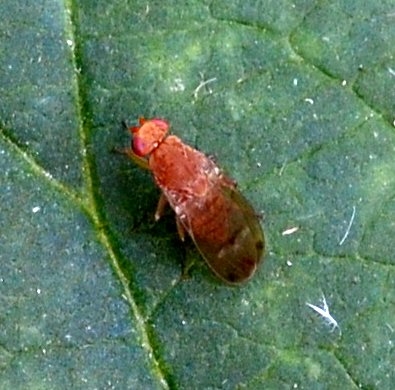

This little black fly ought to be so much easier to identify than it is! It sort of looks like a stealth bomber, doesn't it? We have seen it fairly often, and it is the smoky-winged Woodlouse Fly. The picture-winged fly is back. They seemed to be more ubiquitous last year! Here's another yellow-winged fly, but a different species, and a large fly only a mother fly could love!
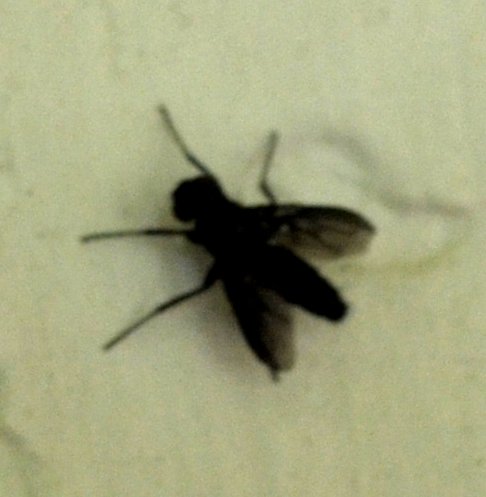
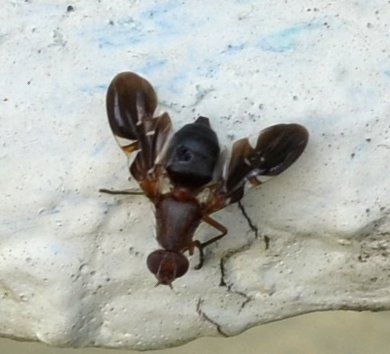

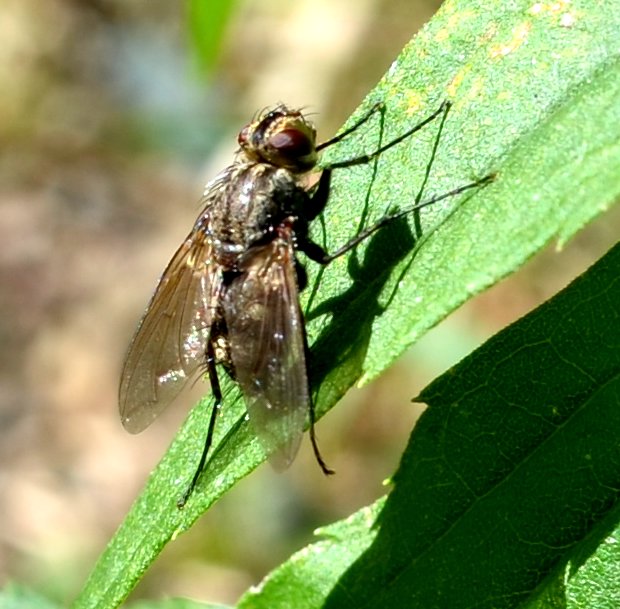
Beauty break -- Here are some of the flora that are still in season. First, the hibiscus - it's slowing down quite a bit as the nights are cooler, but still refreshing flower by flower. I paint the house that color to set off these flowers. Do you remember the colchicums? They shoot up lots of leaves in early spring, then disappear. But they are gathering strength to burst into bloom (sans leaves) in the fall. The saffrons ("fall-blooming crocus") do the same, but I haven't seen any of their blooms yet this year. In the front yard, there was only this single colchicum flower, but it was so wide open and just large that it was impressive all on its own. Looking back at the image with multiple flowers, you can now understand why the mass of heavy blooms is so vulnerable in the rain. Oh, you know, that big "colchicum" just might be a splayed-out saffron crocus.
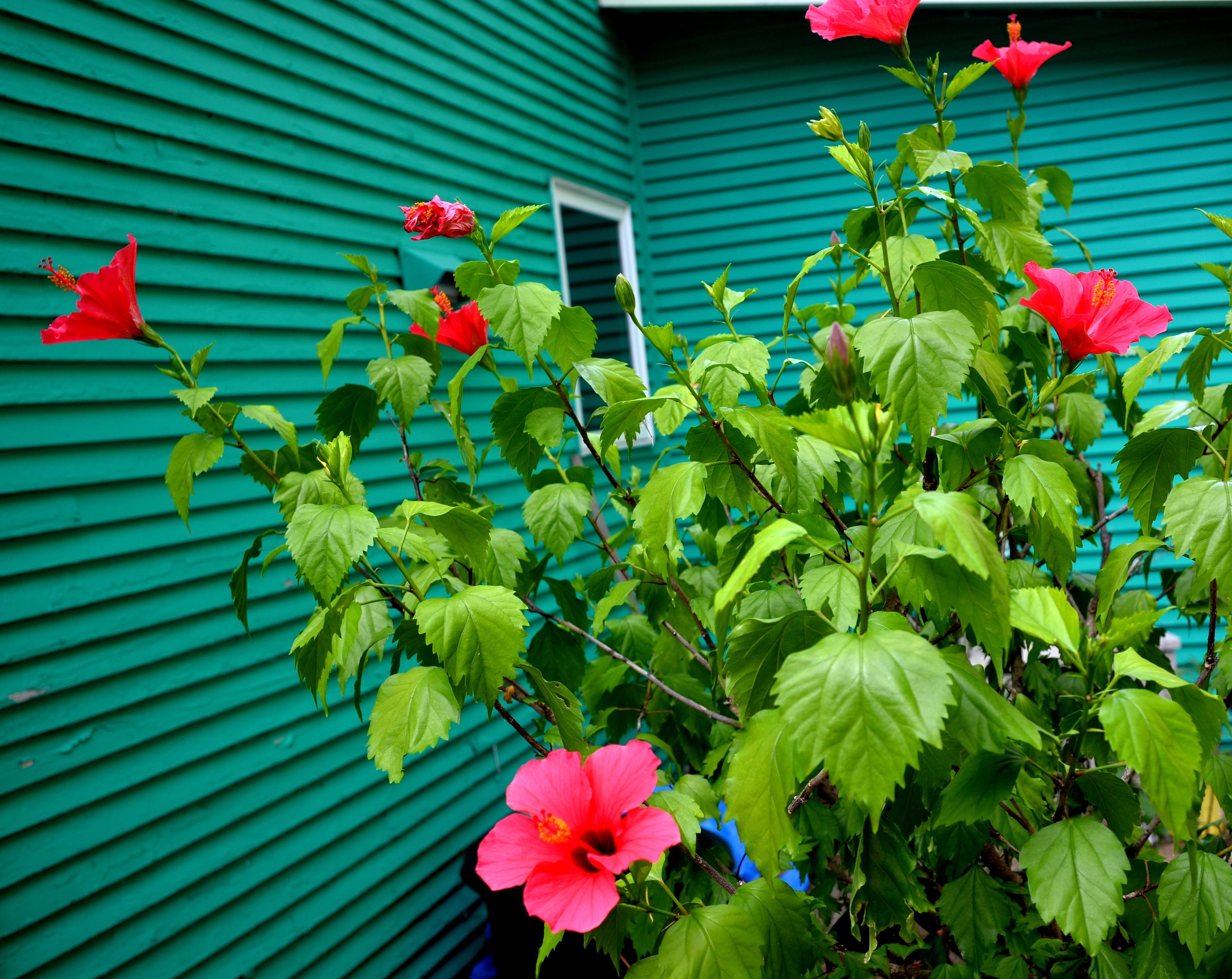
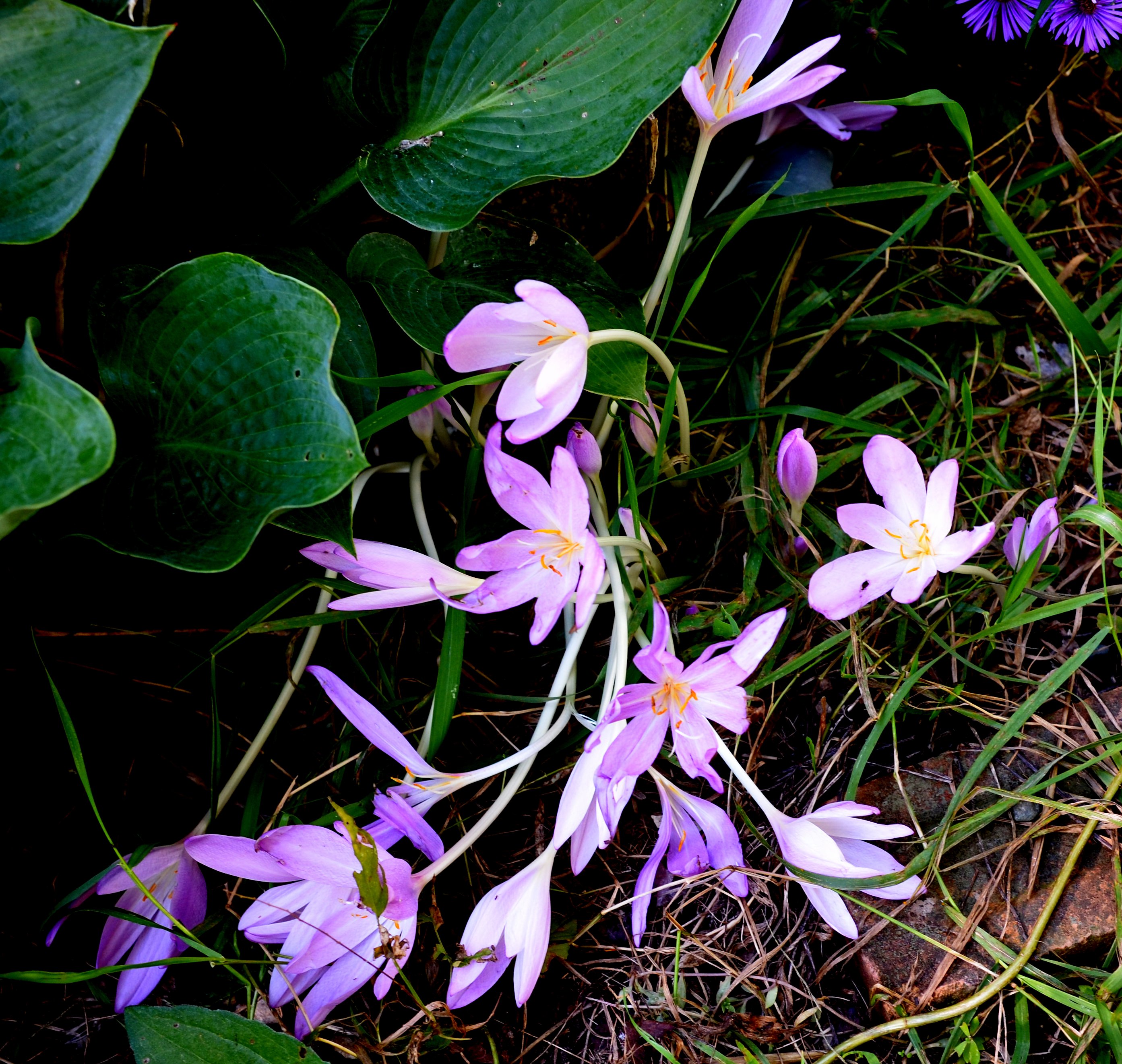
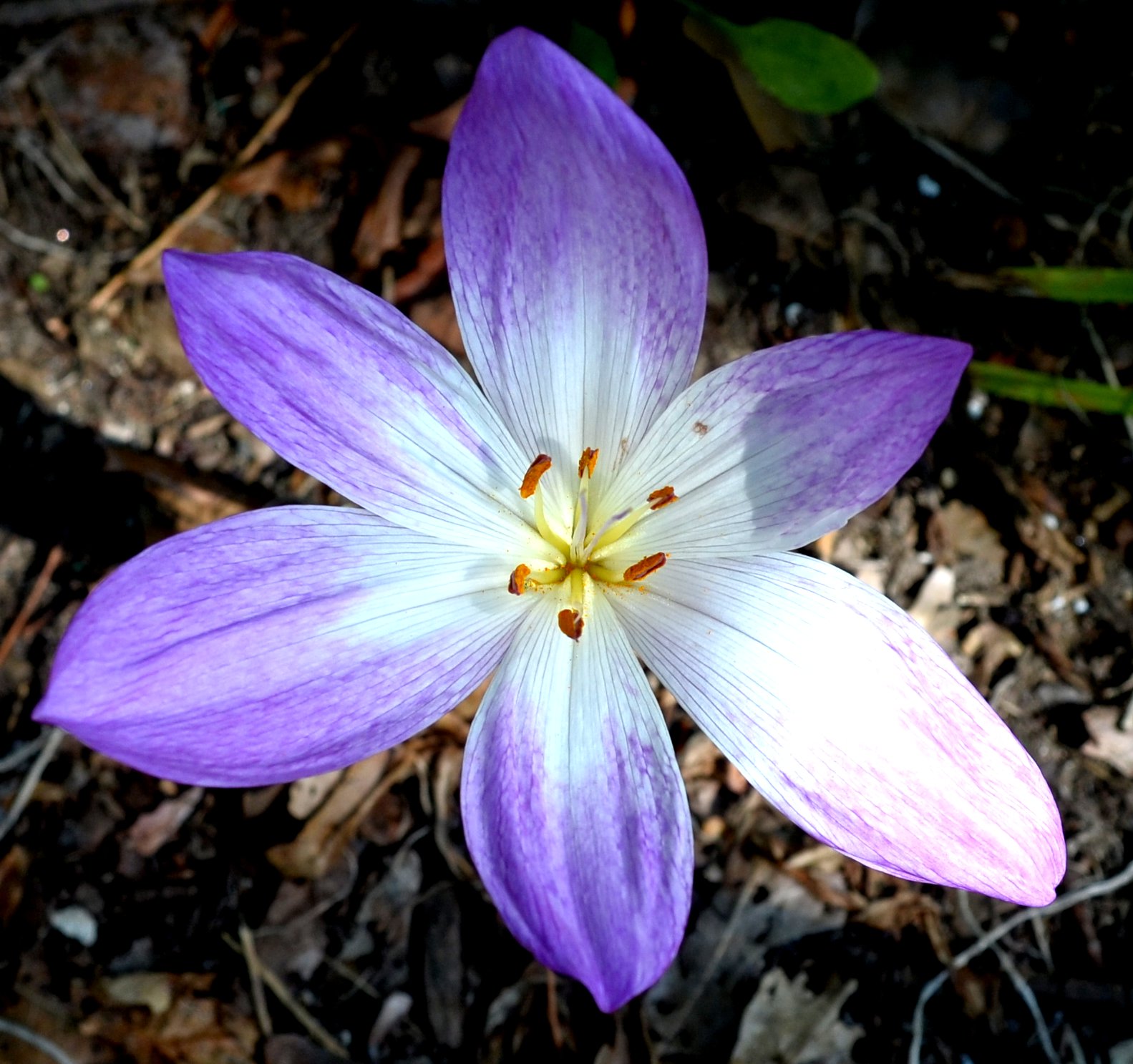
For some reason, I waited till now when we're almost ready for moths to say that we do get a very few butterflies. If you are a cabbage (or any Brassica) farmer, you don't have quite the emotional attachment to the beautiful white cabbage butterfly as others. This is because the beautiful little green caterpillars are hell on cabbage relatives. The skippers look like butterflies but most of them do have a skippy gait when in the air. This one and the next are mystery skippers, as are so many skippers to so many people. The first skipper was across the pond from me so isn't too clear. The second one was flitting from aster bloom to bloom so it isn't too clear. See how many excuses you can generate by saying "Uh, it's a skipper or something".
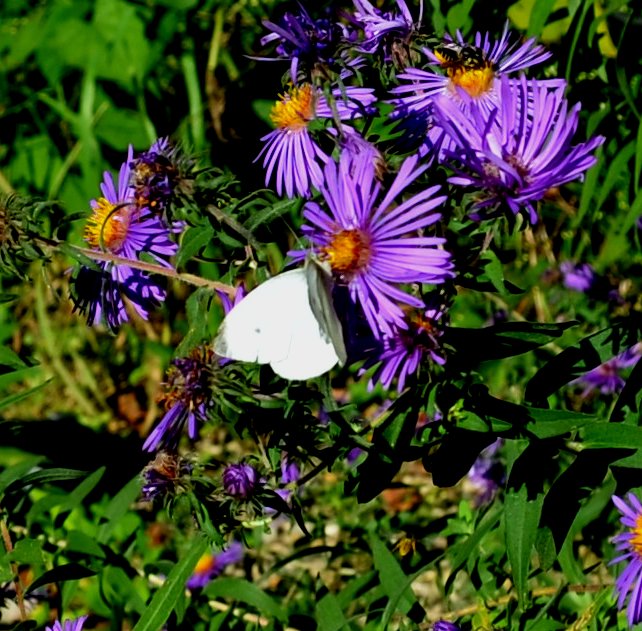
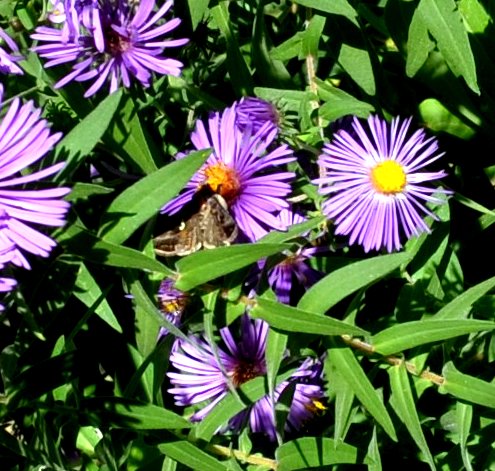
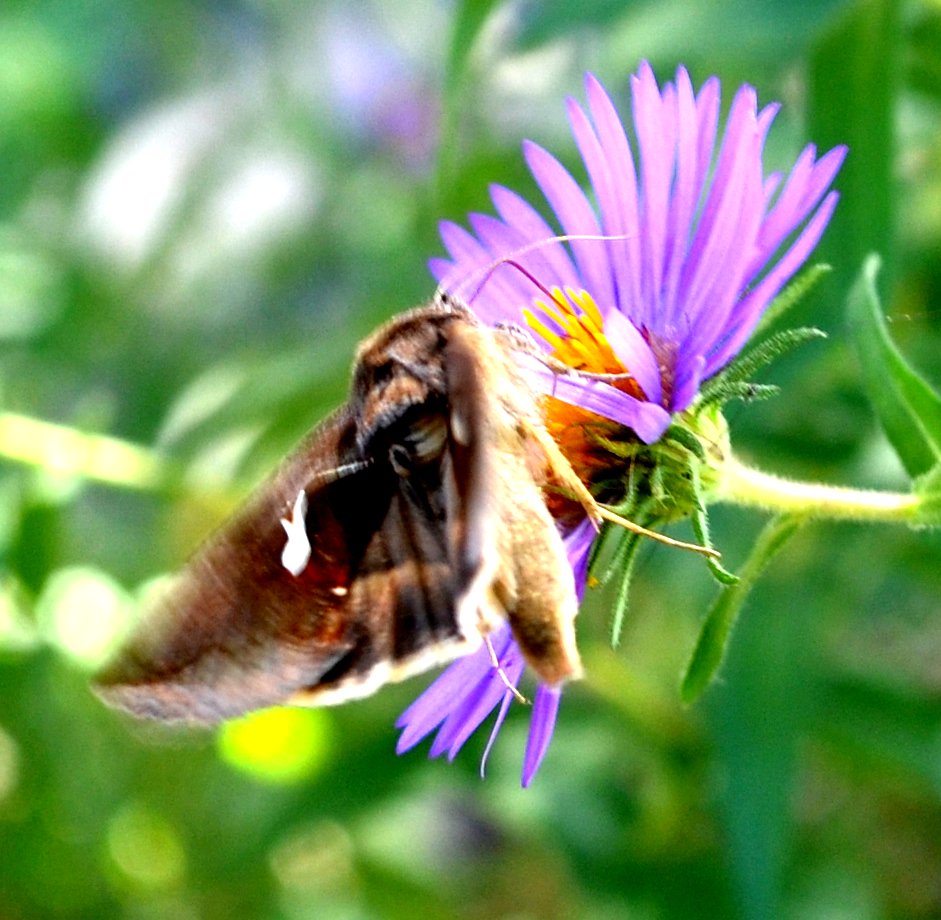
This one is the popular Silver-Spotted Skipper, popular because it's fairly large and so the most recognizable of all the skippers around here. Meanwhile, this hairy moth appeared on the shop wall a few days ago. The last one was right down on the ground. Another excuse to take only an uninspiring picture.

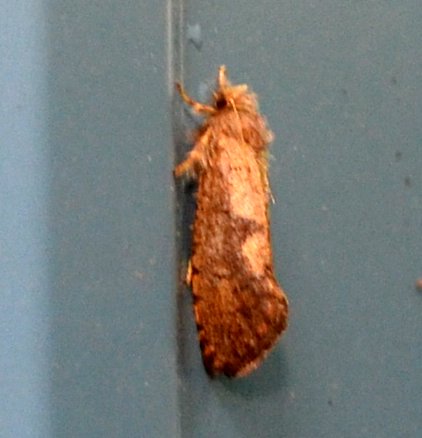
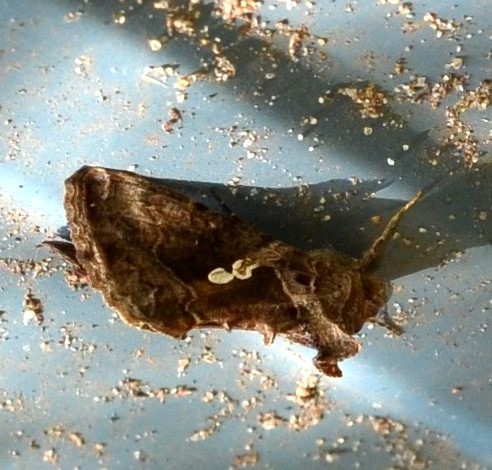
Where have all the grasshoppers and katydids gone? Remembering how large they were last we spotted them, they must by now have procreated and will now pass the winter as eggs or nymphs somewhere. But the crickets have been good to me this year. Here is another jumping bush cricket, a female if you notice such things. With a missing hopping leg, I wonder how much jumping she is likely to do. But someone will find her and assure the continuation of the species. See, even Sheila's kids can read this with no harm done. The next two are tree crickets. Have you noticed how many tree crickets there are? We had the Jumping Bush Cricket, the Snowy Tree Cricket, and now the Pine Tree Cricket. This pair must have been raised on blue spruce (that's the big tree on the other side of the shed.) It is a little difficult to decide which is the girl (the first one) and which is the boy (the second).
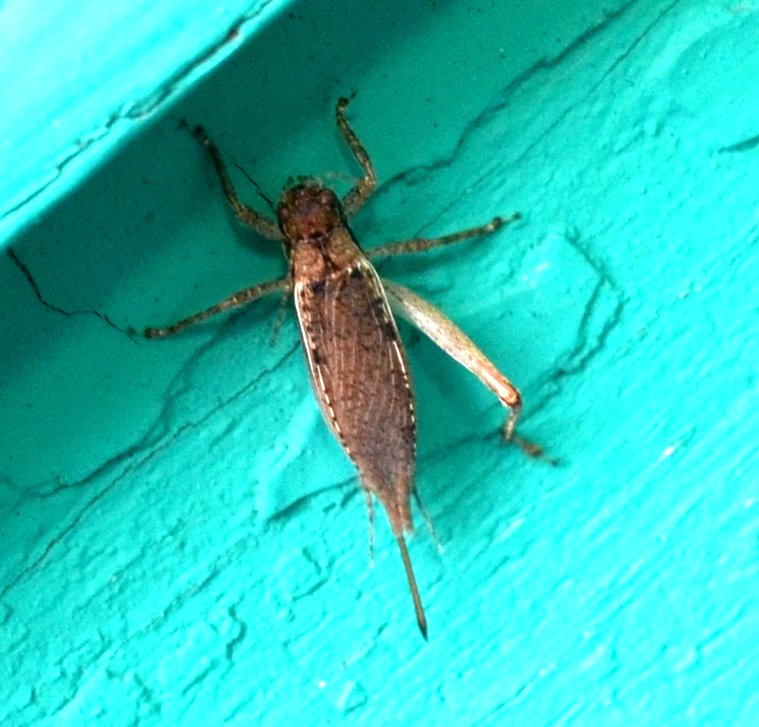
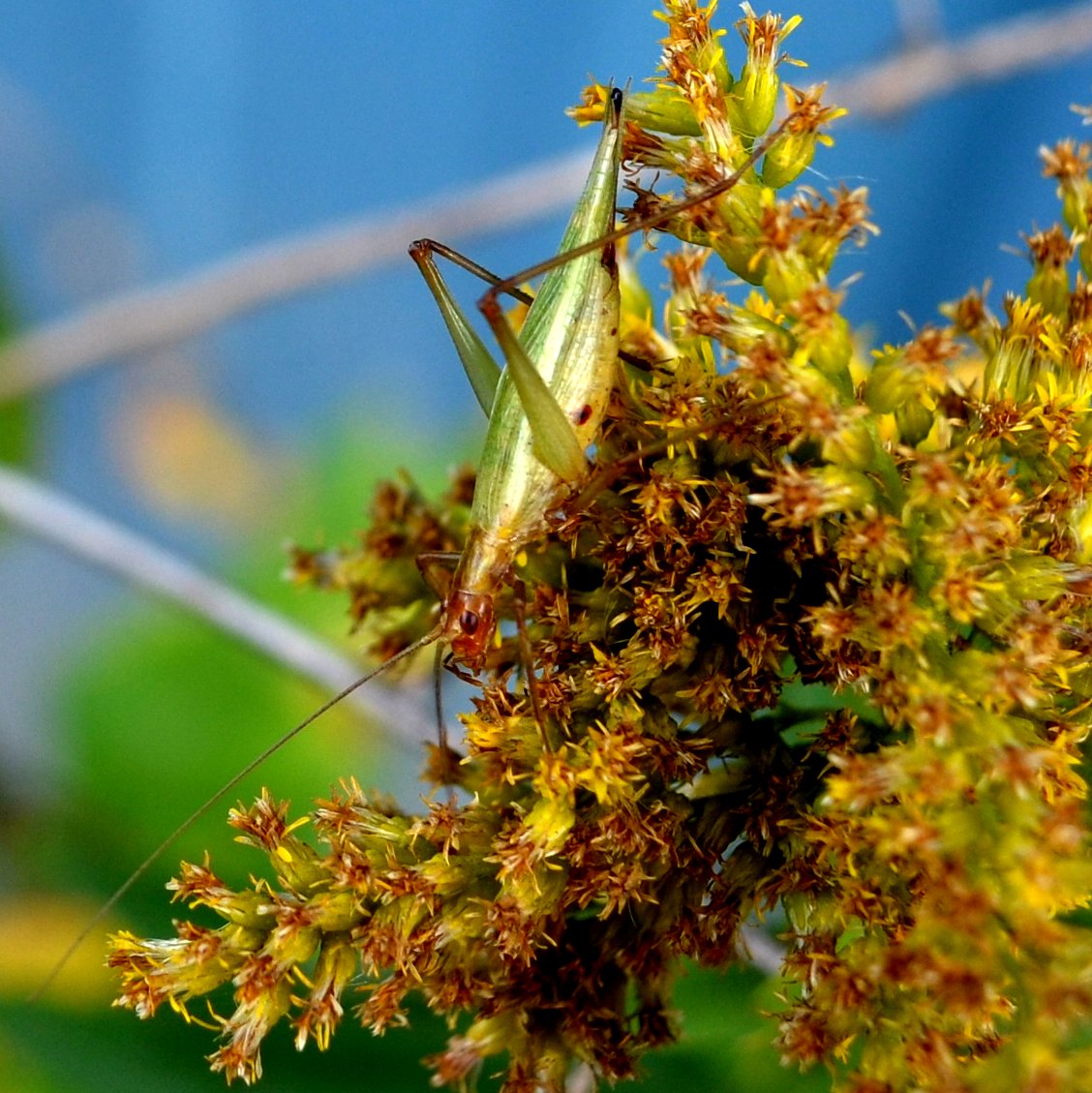

I'm always happy when Biddy writes and says how much she loves spiders. I do too. This year they seem a little farther between. In fact, last year the Bowl and Doily Spider was almost a weekly star for a long time. This is the first one I've seen this year! In fact, looking closer at the reddish legs this could be a male CHS. The second one here is the good old friend, the Common House Spider. Why haven't I ever seen one in the house? They all seem to hang out on the east (shadiest) side of the shop. In picture 3, you see one preparing dinner - a huge beetle, maybe a weevil. They can actually subdue insects MUCH larger than themselves. You may think some of that prey is going to go to waste, but look at the carcass produced by this one!
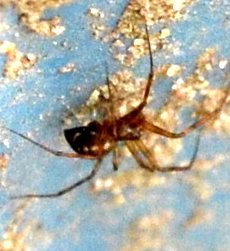
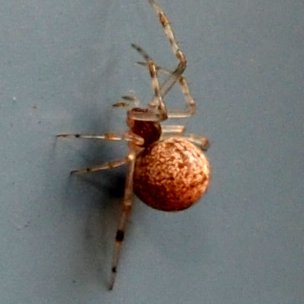

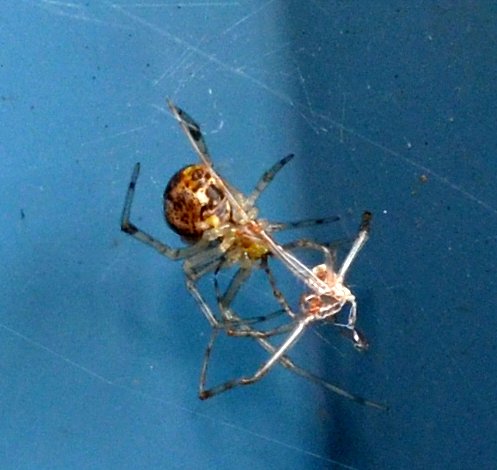
Here's a nice jumping spider. The design on its abdomen almost seems carved. Next is an orbweaver who was hanging from the porch ceiling a few feet above me. Last is a lump of assorted leftovers compacted for easy cleaning of someone's web.
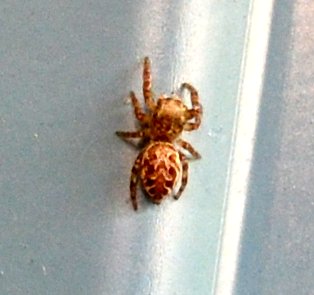
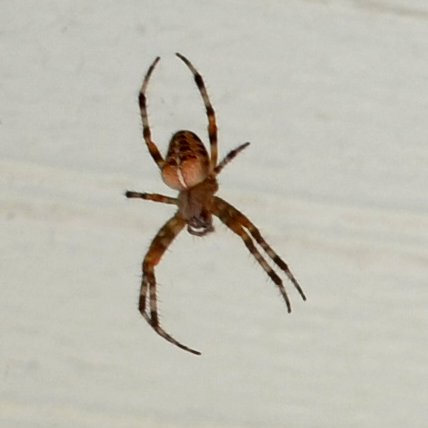

If you watch your feet around wasps, not only are you less likely to maim a wasp and suffer the consequences, but you also stand a chance to see something extraordinary. Here's a wasp (an Arial Yellowjacket male) trying to collect a fallen caterpillar to which the ants have laid claim. Wasps frequently collect caterpillars or other such small food objects to take to their nests to feed the babies. I'm thinking this is an ichneumon wasp but don't have anything to compare it with. The last one is definitely an ichneumon and we've seen it a few times this year, I believe.
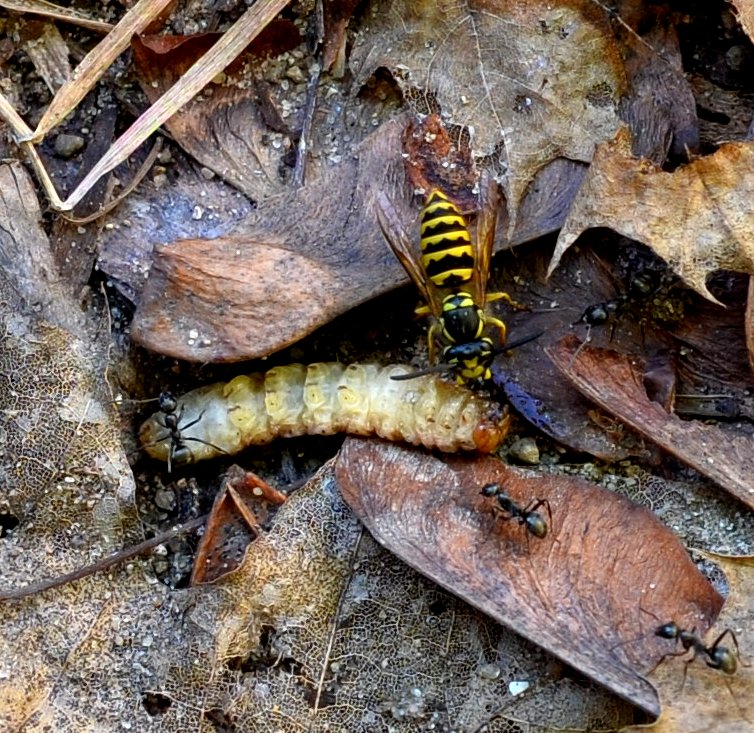


The wasps are almost gone for the season now that the goldenrod has fewer and fewer patches of yellow flower. This is the potter wasp called Ancistrocerus adiabatis. The second picture shows the happy face on the thorax. I think that's about it, but of course you need another cat and bunny fix. So here they are.

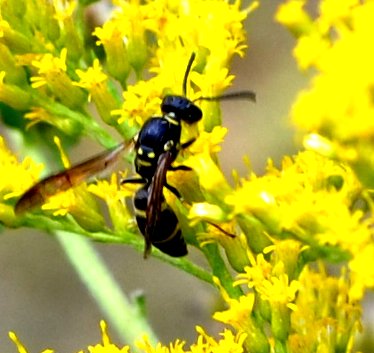

It has been a long day but I think this blog is about ready to go out. So tomorrow I'll proof it again and it will be sailing at the speed of light to you. Hang in there, cronies!
Love, Martha
Back to September 25
On to October 9
Back to 2016 menu
Back to main menu
copyright Martha O'Kennon 2016






 <
<




























































